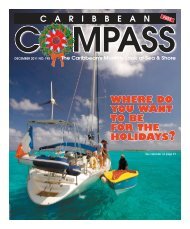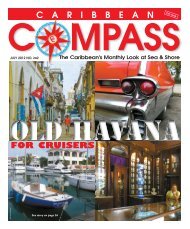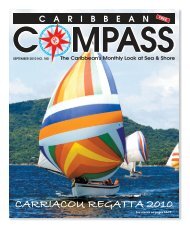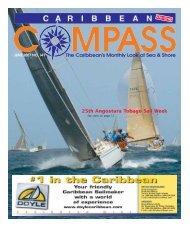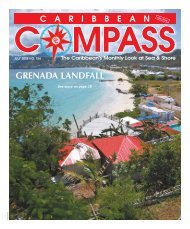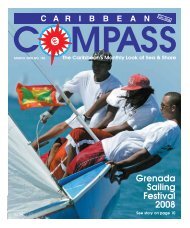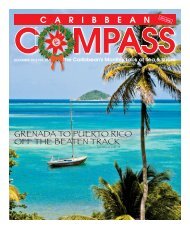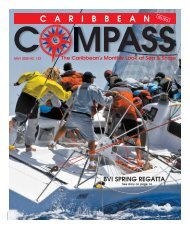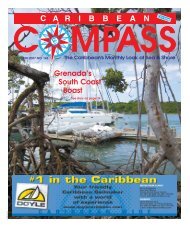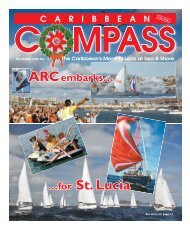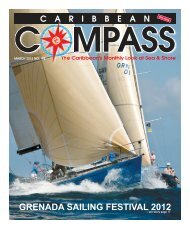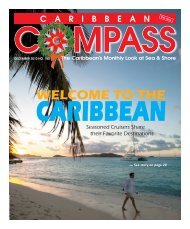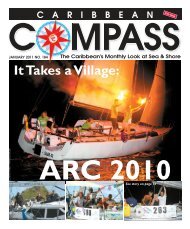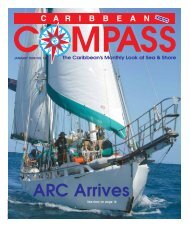Carriacou Regatta Festival 2007 - Caribbean Compass
Carriacou Regatta Festival 2007 - Caribbean Compass
Carriacou Regatta Festival 2007 - Caribbean Compass
You also want an ePaper? Increase the reach of your titles
YUMPU automatically turns print PDFs into web optimized ePapers that Google loves.
BOOK REVIEW BY BOB BERLINGHOF<br />
Buccaneers<br />
vs. Pirates<br />
In Search of the Buccaneers, by Anthony Gambrill ©<strong>2007</strong>. Macmillan<br />
<strong>Caribbean</strong>. Hardback, 258 pages, with illustrations, maps, glossary, index, and bibliography.<br />
ISBN: 978-0-333-97652-4.<br />
Anthony Gambrill has been interested in buccaneers since obtaining a rare copy<br />
of Alexander Exquemelin’s Bucaniers of America, published in 1684. He has lived<br />
in Jamaica for 50 years and is chairman of a large advertising agency; in 1998 he<br />
received his Master’s degree in History. Mr. Gambrill has created a thoroughly<br />
researched and beautifully illustrated text covering the glory days of the buccaneers,<br />
from 1630-1700.<br />
He posits that the buccaneers (whose name derived from their practice of smoking<br />
meat over a wooden barbecue grill, or boucan) were not pirates, though their<br />
exploits — such as raping, pillaging, and plundering — came perilously close to<br />
piracy. The difference, and it is a fine legal one, was that the boucaniers were mercenaries<br />
who were usually (but not always) engaged in state-sanctioned terrorism<br />
against their enemies. Furthermore, the buccaneers experimented with a form of<br />
democracy a century before Thomas Jefferson. This allowed the Dutch, French, and<br />
English buccaneers to ally in sacking Spanish cities in the <strong>Caribbean</strong>. The buccaneers’<br />
six decades of success and eventual dissolution ultimately led to the encouragement<br />
of greater colonization in the West Indies by Spain’s European rivals.<br />
After Columbus, Spain ruthlessly pursued the New World’s gold, silver, sugar<br />
and dyes; they outlawed colonization by their rivals, and even trading with other<br />
European powers was forbidden. This was as unenforceable as it was impractical,<br />
and rogue traders from other nations found markets for their goods with Spanish<br />
merchants. French pirates and “privateers” (those with Royal sanction) such as<br />
Hawkins and Drake attacked Spanish settlements with gusto in the 16th century,<br />
forcing Spain to fortify its ports. As the mineral-rich mainland settlements at Vera<br />
Cruz, Cartagena, Portobello and Nombre de Dios drew colonists away from Santo<br />
Domingo, many farms in Western Hispaniola (Haiti) were abandoned and their livestock<br />
roamed the countryside. In 1605 a Spanish decree was issued to abandon all<br />
remaining haciendas in Western Hispaniola, since the Crown couldn’t afford to<br />
defend them. Owners were ordered to move to the city of Santo Domingo, which<br />
was heavily fortified.<br />
The boucaniers were frontiersmen living off the wild cattle and pigs from these<br />
abandoned Spanish settlements on the north and west coasts of Haiti. Rough and<br />
rugged, they honed their marksmanship skills by hunting, and they survived by<br />
trading meat and skins for gunpowder and shot, living in camps much like the<br />
indigenous Taino Indians. They cured their meat over open fires on raised sticks of<br />
lignum vitae, lived in conical huts held up by a centre pole, and slept in hammocks.<br />
Their members consisted of shipwrecked sailors, deserters, English and French<br />
colonists escaping religious persecution or Spanish retribution, former indentured<br />
servants, freed slaves, and even a few Indians.<br />
They were not averse to taking Spanish ships as prizes, which they originally<br />
attacked from dories, until they became a nascent naval power. As their numbers<br />
increased, the Spanish tried to wipe them out. This forced them to pool their<br />
resources and develop leaders and plans for their common defense. Eventually,<br />
many made the two-mile journey to the island of Tortuga, off Haiti’s north coast,<br />
to get farther away from their Spanish tormentors and built a defensible port.<br />
Tortuga before 1630 had so many wild hogs that it was called the Island of Pigs<br />
(L’isle de Porceaux). Some of the settlers were English colonists from Nevis who had<br />
been displaced by the Spanish attack there in 1629. Tortuga became the first<br />
colony in America not governed by a colonial power. Alas, the experiment in democracy<br />
was unsuccessful as the English and French settlers fought, and in their<br />
weakness they were attacked again by the Spanish. Eventually Jean LeVasseur<br />
was appointed governor, but once in power he became a despot solely interested in<br />
amassing a fortune. A fort was built overlooking the harbour, and LeVasseur<br />
reigned like a king for 12 years.<br />
The English buccaneers, meanwhile, had joined the armies of General Venables<br />
and Admiral William Penn (the father of the founder of Philadelphia) in 1655 and<br />
taken the island of Jamaica from Spain. Port Royal, the capital, became the Sodom<br />
and Gomorrah of the western world and the base for such notable leaders of<br />
English buccaneers as Christopher Myngs, Edward Mansfield and Henry Morgan.<br />
As governor of Jamaica, Sir Thomas Modyford sold “commissions”, or letters of<br />
marque, for 20 pounds each, legally allowing buccaneer captains to pillage Spanish<br />
ships and towns so long as the Crown got its cut — 16.66 percent.<br />
Meanwhile, on board the buccaneers’ ships, captains could be voted out if they<br />
lost favour with their crew, and the crew’s pay was strictly determined by a percentage<br />
of the booty obtained (“no purchase, no pay” or “no prey, no pay”), after<br />
expenses. Morgan’s looting of Portobello, Panama, in 1668 netted his crew — over<br />
700 men on 12 ships — a massive 120 pounds per person, while his more daring<br />
feat of taking Maracaibo, Venezuela, in 1669 netted a crewman only 30 pounds.<br />
This money was generally squandered on drink and women in Port Royal, whose<br />
purveyors were the great beneficiaries, but merchants and other colonists were<br />
also positively affected by the sudden influx of such great wealth. The marvelous<br />
cover art of In Search of the Buccaneers depicts such a debauched scene and is<br />
taken from a French painting that now hangs in the Marine Museum in Paris.<br />
The chapters of this book describe the buccaneers’ campaigns geographically,<br />
rather than chronologically, and are mind-bogglingly comprehensive in describing<br />
the various Dutch, French, English and Spanish leaders, governors, admirals and<br />
captains of the day. It is a little confusing to be backtracking in time during some<br />
chapters, but the number and range of hostilities reported lead one to conclude life<br />
was not easy for the early colonists, who were constantly being preyed upon by<br />
agents of hostile nations as well as being victims of smallpox, yellow fever, dysentery<br />
and tuberculosis.<br />
The buccaneers’ story ends around 1700, although piracy flourished for another<br />
half century and has continued to this day. By the 18th century the buccaneers’<br />
type of legalized piracy was considered counterproductive by their rulers in Europe<br />
— the galleons of Spanish gold and silver were in decline, and peace briefly flourished<br />
among the old adversaries. Instead of bringing in wealth, the buccaneers’<br />
exploits were hurting the fragile stability of the colonial planters and deemed bad<br />
for business.<br />
In 1692 Port Royal suffered a cataclysmic earthquake; thousands drowned when<br />
two-thirds of the port slid into the sea. By that time, Henry Morgan had been jailed<br />
to appease the Spanish, released from the Tower, knighted, and had lived out his<br />
years as lieutenant-governor of Jamaica. When he died in 1688 he left an estate<br />
worth over 5,000 pounds, but his grave sank into the sea when Port Royal was<br />
submerged, a fitting end for the world’s most famous buccaneer.<br />
MAC’S PIZZERIA<br />
In addition to our famous pizza we offer<br />
seasonal specialties and fresh baked goods.<br />
Open from 11:00am to 10:00pm.<br />
Closed on Mondays<br />
Situated in Admiralty Bay, Bequia between<br />
the Frangipani and Plantation House.<br />
For Reservations: VHF Ch68 or Tel: (784) 458 3474<br />
SEPTEMBER <strong>2007</strong> CARIBBEAN COMPASS PAGE 33



